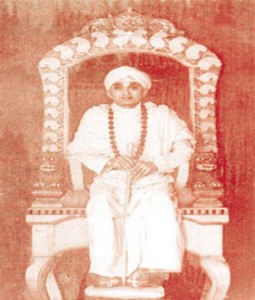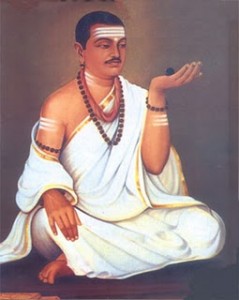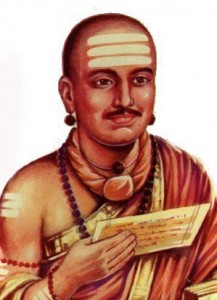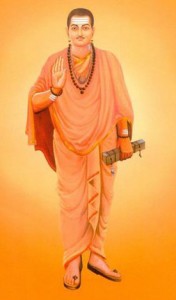
Some Basic information about Lingayat Introduction / History
The Lingayat people are known for wearing a linga, an object representing God; in this case, Shiva. They are a numerous group in India, especially in the state of Karnataka.
This group formed in the 12th century by Basava, a philosopher and a social reformer. He taught against the caste system and its regulations. He envisioned a casteless society, though the resulting society eventually began drawing up lines of caste distinctions again, creating their own hierarchy of social status after Basava's death.
Basava consented to the marriage of a Brahmin woman and a man from an untouchable caste. This story reached the ears of King Bijjala who punished the couple by putting out their eyes and dragging them to their deaths behind an elephant. Basava saw this punishment as unacceptable and left Kayla. He moved on to Kudula Sangama where he died in 1167.
Where are they located?
They are found primarily in Karnataka, where they comprise a major population. They are also found in significant numbers in Maharashtra and Andrah Pradesh.
What are their lives like?
The Lingyat are vegetarian and refrain from alcoholic drinks. They are known to be a progressive people and there are people from many walks of life and religious expression to be found among them. Most work in government service, but they are from many occupations, including artisans, cultivators and priests.
What are their beliefs?
They have a series of initiatory rites, including Lingadharane, the bestowing of the linga. This rite is usually performed within the first week of a child's life. From this day forward, the person will wear the stone as an act of worship of God (Shiva), in a box around their neck. The linga is not seen as a mere representation of God, but rather God himself They adore Shiva, but Basava taught that his worshipers should worship him alone rather than numerous gods. Lingayats reject polytheism and the Vedas and follow the teachings of the Vachana sahitya instead.
Lingayatism, is a distinct denomination within Hinduism in India. It makes several departures from mainstream Hinduism. The adherents of this faith are known as Lingayats the term is derived from Lingavantha in Kannada, meaning 'one who wears Linga on their body'.
Early history
Main article: History of Lingayatism Lingayatism was founded by Vishwaguru Basavanna. Basava lived in the 12th century (1134 - 1196 CE). When he was young, he travelled from his native Bagevadi to Kalyan in India between 1157 - 1167 CE during the rule of King Bijjala.
It is said that Basava, though born a Brahmin, rebelled against the rigid practices of the caste system then prevalent in Hinduism, and eventually began expounding his own philosophy with a casteless society at its core. Soon, his philosophy began attracting large numbers of people. Saints like Allama Prabhu, Akka Mahadevi and Channabasavanna also played pivotal roles in the spreading of the message and the true meaning of Lingayatism.
Basava lived and taught in the northern part of what is now Karnataka. This movement found its roots during the brief rule of the southern Kalachuri dynasty in those parts of the state. Like Martin Luther who came about three hundred years after him, Basavanna preached that the devotion of people to God was a direct relationship and did not need the intervention of the priestly class. Temple building is generally not practised among Lingayats.
Worshiping God
The Lingayaths worship Ishthalinga. Vishwaguru Basavanna, in one of his famous Vachana says, that GOD has no specific form, name, and place. He is omnipresent, unique, Kind and Friendly. Ishthalinga is worn on body. Any human being on earth can wear Ishthalinga initiated by Guru of Lingayat religion. Lingayatism does not make any partiality of humankind based on caste, creed, gender, language, country, or skin colour. Everybody is equal in the eyes of GOD. Lingaytism stands for Fatherhood of GOD and Brotherhood of all Human beings, and compassion towards all living beings. While Hindus believe that one's sins can be washed away by bathing in the Ganga River, Lingayats do not believe in such practices. They also do not believe in rituals and astrology. They believe in "Jangama (mobile) linga" carried in/on one's body as against "Sthavara (stationary) linga" such as in temples.
Lingayat theology
The early followers and adherents believed in a monotheistic world where Linga is the supreme God and the Self and God are one and the same. Early Lingayats placed importance on the Vachana sahityas, which was given by Lord Basava.
Central to Lingayat theology are five codes of conduct (called Panchacharas), eight "shields" (Ashtavarana), and the concept of six levels of attainment that the devotee can achieve (known as Shatsthala).
Panchacharas
The Panchacharas describe the five modes of conduct to be followed by the believer. The Panchacharas include: Lingachara - daily worship of the personal Sivalinga Sadachara - attention to vocation and duty Sivachara - acknowledging Shiva as the one God and equality among members Bhrityachara - humanity towards all creatures Ganachara - defence of the community and its tenets
Ashtavarana
The Ashtavaranas, the eightfold armour that shields the devotee from extraneous distraction and worldly attachments.
The Ashtavaranas include: Guru - obedience towards Guru, Linga - wearing a linga, Jangama - worship of Shiva ascetics as an incarnation of the Lord himself, Padodaka - sipping the water from bathing the Linga, Prasada - sacred offering, Vibhuti - smearing holy ash (created using cow dung) on oneself, Rudraksha - wearing a string of rudraksha (holy beads) and Mantra - reciting the mantra "Namah Shivaya" and not "Om Namah Shivaya" or "Om Namah Shivaya Namaha", Since Namah Shivaya Is a Panchaakshari Mantra(5 Letters) Where as Om Namah Shivaya is a Shatakshari Mantra(6 Letters). Hence Namah Shivaya is the mantra recited.
Shatsthala
Shatsthala, or the concept of six phases/states/paths, is pivotal to the Lingayat philosophy. Shatsthala is a conflation of Shat and Sthala, which means 'six phases/states/levels' through which a soul advances in its ultimate quest of realisation of the Supreme. The Shatsthala comprises the Bhakta Sthala,Maheshwara Sthala, Prasadi Sthala, Pranalingi Sthala, Sharana Sthala and the Aikya Sthala. The Aikya Sthala is the culmination where the soul leaves the physical body and merges with the Supreme.
While the origins of the Shatsthala may be traced to the Agamas, particularly the Parameshwaratantra, with the evolution of Veerashaivism the evolution of the concept of shatsthala was also unavoidable. While Basava understood shatsthala as a process with various stages to be attained in succession, Channabasavanna, Basava's nephew, differed radically from his uncle and held that a soul can reach its salvation in any stage.
Concept of Shoonya
True union and identity of Shiva (Linga) and soul (anga) is life's goal, described as shoonya, or nothingness, which is not an empty void. One merges with Siva by shatsthala, a progressive six-stage path of devotion and surrender: bhakti (devotion), mahesha (selfless service), prasada (earnestly seeking Siva's grace), pranalinga (experience of all as Siva), sharana (egoless refuge in Siva) and aikya (oneness with Siva). Each phase brings the seeker closer, until soul and God are fused in a final state of perpetual Siva consciousness, as rivers merging in the ocean.
Anubhava Mantapa
The Anubhava Mantapa was an academy of mystics, saints and philosophers of the Lingayata faith in 12th century Kalyana. It was the fountainhead of all religious and philosophical thought pertaining to the Lingayata. It was presided over by the mystic Allama Prabhu and numerous sharanas from all over Karnataka and other parts of India were participants. This institution was also the fountainhead of the Vachana literature which was used as the vector to propagate Veerashaiva religious and philosophical thought. Other giants of Veerashaiva theosophy like Akka Mahadevi, Channabasavanna and Basavanna himself were participants in the Anubhava Mantapa.The Anubhava Mantapa was originally called the Shivanubhavamantapa.
Lingayat customs and practices
Ishtalinga
The Lingayats make it a point to wear the Ishtalinga at all times. The Istalinga is made up of light gray slate stone coated with fine durable thick black paste of cow dung ashes mixed with some suitable oil to withstand wear and tear. Sometime it is made up of ashes mixed with clarified butter. The coating is calledKanti (covering). Though the Ishtalinga is sometimes likened to be a miniature or an image of the Sthavaralinga, it is not so. The Ishtalinga, on the contrary, is considered to be Lord Shiva himself and its worship is described as Ahangrahopasana.
Thus, for the Lingayats it is an amorphous representation of God. Lingayat thus means the wearer of this Linga as Ishta Linga. Here the word Ishta is a Sanskrit term meaning 'adored' or 'desired'. Unlike Advaitins however, Lingayats do not treat the Ishtalinga as merely a representation of God to aid in realising God but worship the Ishtalinga itself as God. Lingayats eat only vegetarian food and should not consume meat of any kind including fish. Drinking of liquor is strictly prohibited.

Lingadharane
Lingadharane is the ceremony of initiation among Lingayats. Though lingadharane can be performed at any age, it is usually performed when a foetus in the womb is 7-8 months old. The family Guru performs pooja and provides the instalinga to the mother, who then ties it to her own instalinga until birth. At birth the mother secures the new instalinga to her child. Upon attaining the age of 8-11 years, the child receives Diksha from the family Guru to know the proper procedure to perform pooja of instalinga. From birth to death, the child wears the Linga at all times and it is worshipped as a personal Istalinga. The Linga is wrapped in a cloth housed in a small silver and wooden box. It is to be worn on the chest, over the seat of the indwelling deity within the heart. Some people wear it on the chest or around the body using a thread.
Unlike brahmin beliefs in Hinduism, which permit only males to participate in the Upanayana or Deeksha ceremonies, both Lingayat men and women participate in these ceremonies in the presence of a satguru. This practice was begun by Basavanna himself, who refused to undergo Upanayana, because it discriminated against women.
Kaayakave Kailaasa
This is originally a Sanskrit phrase, Vrutti Chaitanya Roopini Karanika, preached by Jagadguru Renukacharya. Kaayaka means the exertion of the Kaaya(body) for the liberation of the soul imprisoned therein. Kailaasa means "abode of Shiva" - heavenly.
Kaayakave Kailaasa literally means, Kaayaka or the body which exerts itself for nishkaama Karma - Karma without any expectation is nothing but Kailaasa - the abode of Shiva - heavenly. There is a vachana complementary to this which talks about keeping the Kaaya (body) pure:
Yenna kaale kamba dehave degula shirave honna kaLashavayya sthaavarakkaLivuntu jangamakkaLivilla - meaning, 'My legs are the pillars, my body the temple, and my head the golden spire. That which is immobile is transient. That which is mobile is not.' As one theory goes, the Indian subcontinent is divided into North and South by the Vindhya mountain ranges. While the North has the Himalayan rivers flowing year - round and boasts the river Ganges, the South has the river Kaveri, which originates at Talakaveri and dries up in the summer. Hence the North is referred as Punya Bhoomi, whose residents believe that taking a dip in the Ganges with Bhakthi will wash off all your sins. But the South is referred as Karma Bhoomi, whose residents believe that their Karma which will decide their fate. The Kaayaka Tatva of Basavanna also bases itself on the Karma Siddhantha (Philosophy of Karma).
Daasoha
Among the many injunctions prescribed for the devout Lingayat, Daasoha is a very important one. Basava created this as a protest against the feudalistic ideologies present at that time. He shunned the sharp hierarchical divisions that existed and sought to remove all distinctions between the hierarchially superior master class and the subordinate, servile class. Even though he himself served as a minister under the king, Bijjala, he pointed out that he worked only as a daasohi or one who serves. Daasoha to him meant working hard for one's livelihood and for the maintenance of society. In Basava's view, adaasohi should consider himself, but a servant of society. Therefore, daasoha in principle assumed that what belongs to God must return to Him and what came from society should be given back by way of selfless service. Basava exhorted all wearers of Ishta linga to practice daasoha without reservation. A famous vachana says: Soham yennade Daasoham yendenisayya - which means "be selfless [Daasa Aham] rather than selfish [Naanu or Aham]".
Burial
Unlike most Hindus who cremate the dead, the Lingayat sect buries its dead. The dead are buried in the Dhyana mudra (meditating position) with their Ishta linga in their left hand.
Festivals
Main articles: Basava Jayanthi and Maha Shivaratri

Lingayata literature
Main articles: Vachanas and Vachana Sahitya
The rise of Lingayatism heralded a new chapter in the annals of Kannada literature. Basavanna and other saints communicated their beliefs and ideas in Kannada which was the commoners' language unlike Sanskrit which was understood only by the highly learned at the time. It saw the birth of the Vachana style of literature with the Veerashaiva philosophy at its core. The Vachanas were pithy poems of a devotional nature that expounded the ideals of Veerashaivism. Saints and Sharanas like Allama Prabhu, Akka Mahadevi, Siddarama and Basava were at the forefront of this development during the 12th century. Some of the best vachanas are the padas or the devaranamasof the dasas. The dasas were a group of religious singers of the Madhva faith who wandered around the kingdom singing about social injustice and true worship.Siddarama (Siddarameswar) of Solapur (Sonnalagi) is considered to be one of the five prophets of the Lingayat (Veerashaivism) religion and a Kannada poet who was a part Basavanna's Veerashaiva revolution during the 12th century. Siddharama claims to have written 68,000 vachanas, out of which 1379 remain in existence. His philosophy was one of service to mankind, the path of Karmayoga. He shared the worldview of other vachana poets in his rejection of blind conventions and caste and sex discrimination and emphasis on realization through personal experience. He borrowed metaphors from diverse spheres of everyday life. Apart from vachanas, he wrote several devotional works in tripadi. Sarvagna was a later lingayat vachana poet of the 17th century who wrote thousands of succinct vachanas in tripadi style.
The entire corpus of these works was in Kannada. As with the Dasa Sahitya of the later Haridasas, the Vachanas were also primarily targeted at the common person and sought to demystify God, as large sections of society had been deprived of access to the texts. The Jangamas played a central role in the propagation of the Vachanas.
Lingayat demographics
Lingayats today are spread all over the state of Karnataka though not native to south karnataka. They are Karnataka's largest community with 21% of the state population. Sizeable populations are also found in parts of Maharashtra and Andhra Pradesh bordering Karnataka, Tamil Nadu, Kerala and Gujarat also has Lingayat population. In north India more prominently they are called Kashmiri Shaivites or Veerashaiva. In Karnataka, the Lingayat population is quite large and widespread.
The Lingayat diaspora can be found in countries around the world, particularly the United States, Britain and Australia. The Lingayat community wields considerable clout in the sphere of Karnataka politics. Several important and powerful leaders have been from the Lingayat community.

Lingayata
Basava was the first Lingayat. In Vachana Sahitya all sharanas refer to Basava as the originator of Ishta linga. Ishta linga is the miniaturized approximation of formless, nameless, infinite and omnipresent God. Basava invented the ishtalinga and wore it on his neck, thus becoming first Lingayata. Then he gave deeksha to Akka Nagalambike. Later on Basava gave deeksha to many people. One of them was Animisha, the guru of Allama Prabhu. This is clearly mentioned in Vachana Sahitya. In one of the vachana, Allama Prabhu says, Basava is his Guru's Guru (Parama Guru). Siddharama has written tripadi to prove that Basava is the originator of Lingayatism. Sarvagna also says Basava is the first guru of Lingayatism. Ample examples can be given from vachana sahitya to prove that Basava is Raya Purvacharya or First Acharya. Basava established Anubhava Mantapa to establish spiritual social and economic democracy. People from all walks of life embraced Basava's thoughts and became Lingayats. In the same way, Veerashaivas also embraced Lingayatism and became Lingayats, Veerashaiva lingayats.
While Hinduism converted workmanship into castes, Basava reversed the castes into workmanship again. Hinduism differentiated people based on birth while Basava or Lingayatism offered equal status to all. As a result, large numbers of different caste people took Linga-Deeksha and became Lingayata.
Lingayats and social work
The Lingayat community, under the aegis of several Mathas, has been very active in the field of social work, particularly in the field of education and medicine. Thousands of schools are run by the Lingayat Mathas where education, sometimes free and with boarding facilities, is provided to students of all sections of society irrespective of religion or caste. In addition, various Lingayat organizations run numerous schools, colleges and hospitals across the length and breadth of Karnataka. Some of these institutions also have branches in other states of India. Some of the notable Lingayat-run institutions include the JSS group of institutions, KLE Society and Siddaganga Education Society.
Famous Lingayats
Sree Sree Shivakumara Swamiji, head of Siddaganga Mutt in South India.
Basappa Danappa Jatti, President of India (acting) from February 11, 1977 to July 25 1977.
Vice - President of India from 1974 to 1979.
Pandit Puttaraj Gawai Pontiff of Vireswara Punyasrama, Gadag, Hindustani and Carnatic musician
Shivraj Patil, former Home Minister, Government of India
S. Nijalingappa, former Chief Minister of Karnataka. He played important roles in the Indian independence movement and the Karnataka Ekikarana movement.
Basavaraj Rajguru, Indian classical singer
Mallikarjun Mansur, Indian classical singer
G. S. Shivarudrappa, poet and critic, Rashtrakavi
S. R. Bommai, senior leader Janatha Dal and former CM Karnataka
Veerendra Patil, former Chief Minister of Karnataka
Jayadevappa Halappa Patel, former Chief Minister of Karnataka
B. S. Yeddyurappa, Chief Minister of Karnataka
D. M. Nanjundappa, economist from Karnataka, Vice-chancellor of Bangalore University and Karnataka University
Mate Mahadevi, scholar, mystic, and writer, and the first female jagadguru, or spiritual head of a South Indian Lingayat community
Jagadish Shettar, former Speaker, Government of Karnataka
Gubbi Veeranna, Kannada theatre director
Muguru Sundaram, dance choreographer in South Indian cinema
Prabhu Deva, Indian dancer, choreographer, actor and film director
Kavitha Lankesh, filmmaker and director in the Kannada cinema industry.

 Member Login
Member Login